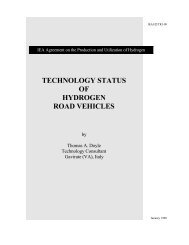Edited by Mary Rose de Valladares M.R.S. Enterprises, LLC ...
Edited by Mary Rose de Valladares M.R.S. Enterprises, LLC ...
Edited by Mary Rose de Valladares M.R.S. Enterprises, LLC ...
Create successful ePaper yourself
Turn your PDF publications into a flip-book with our unique Google optimized e-Paper software.
System surrounds a Reaction Center.<br />
A balance of the amount and capability<br />
of the Light Harvesting System and the<br />
Reaction Center is key to maximizing<br />
production in a real cell culture. Genetic<br />
engineering has been studied to realize<br />
the i<strong>de</strong>al energy entry system.<br />
The physiology and cultivation<br />
of photosynthetic microbes are also<br />
important subjects for maximization of<br />
H2 production from water or organic<br />
wastes. Since the collection of algae<br />
<strong>by</strong> Prof. Mitsui, many important strains<br />
have been found and the mechanism<br />
of electron supply from substrates has<br />
been studied. The metabolic pathway<br />
and the regulation of hydrogenase are<br />
controlled <strong>by</strong> the physiological/physical<br />
condition of the cell and the chemicals<br />
ad<strong>de</strong>d. Methods to control the mecha<br />
nism of the cell are the major subject of<br />
study in science and engineering.<br />
In Norway there has been re<br />
search on algae during sulfur starvation<br />
and the sequencing of hydrogenases.<br />
A number of algae cultures are being<br />
screened with respect to physiological<br />
response to sulfur <strong>de</strong>privation in small<br />
scale laboratory cultures un<strong>de</strong>r con<br />
trolled conditions. Some species of<br />
Chlamydomonas, both freshwater and<br />
cant hydrogen production un<strong>de</strong>r sulfur<br />
<strong>de</strong>privation. Efforts have been ma<strong>de</strong> to<br />
obtain results from axenic cultures and<br />
to eliminate errors caused <strong>by</strong> bacterial<br />
and fungus contamination in the biore<br />
actor. Using PCR reactions, they have<br />
searched for the presence of hydrog<br />
enase genes in marine and fresh water<br />
species of green algae that are able to<br />
produce hydrogen un<strong>de</strong>r sulfur<strong>de</strong>prived<br />
conditions. Work on i<strong>de</strong>ntifying and<br />
characterizing the genes encoding the<br />
hydrogenases is currently in progress<br />
along with comparing the related spe<br />
cies.<br />
Subtask C:<br />
BioInspired Systems<br />
The purpose of this subtask is<br />
to elucidate promising applications of<br />
enzymes and biologicallyinspired pro<br />
cesses for hydrogen production and fuel<br />
cells. The subtask lea<strong>de</strong>r is Swe<strong>de</strong>n<br />
and the colea<strong>de</strong>r is France.<br />
Research of the enzyme hydrog<br />
enase has been done in many coun<br />
tries, including those in Europe, Japan<br />
and the USA. Biological functions are<br />
un<strong>de</strong>rstood at the genetic and molecular<br />
level. However, for practical applica<br />
tions, many improvements are required.<br />
The most important one is the durability<br />
of the protein, especially oxygen toler<br />
ance; more in<strong>de</strong>pth un<strong>de</strong>rstanding of<br />
the protein is required along with the<br />
engineering efforts. Although there has<br />
been international cooperation in basic<br />
studies, cooperation in applied research<br />
has been limited.<br />
The feasibility of hydrogenase/<br />
<strong>de</strong>velopment was proven <strong>by</strong> an inter<br />
national engineering project (a NEDO<br />
international joint research grant pro<br />
gram). The biomolecular <strong>de</strong>vice project<br />
consists of three (3) German groups,<br />
one (1) French group and three (3)<br />
Japanese groups. An extraordinarily<br />
stable hydrogenase was extracted and<br />
provi<strong>de</strong>d <strong>by</strong> the Russian Pushchino<br />
group from Thiocapsa. Photosystem 1<br />
and Photosystem 2 were stabilized <strong>by</strong><br />
either special lipid components (natural<br />
or synthetic lipids) or synthetic polymers<br />
that are called amphipols. An electro<strong>de</strong><br />
with the surface covered <strong>by</strong> hydroge<br />
nase was prepared <strong>by</strong> using the Lang<br />
muirBlodgett method. Photoinduced<br />
electron transfer was observed with the<br />
combination of H2ase electro<strong>de</strong>, PSI<br />
and/or PSII.<br />
The result suggests that the<br />
concept of the hydrogenase<strong>de</strong>vice for<br />
hydrogen production is feasible. Energy<br />
for this process should be provi<strong>de</strong>d <strong>by</strong><br />
the sun and electrons from the water<br />
splitting process of oxygenic photosyn<br />
thesis. The continuous optimization of<br />
these processes will also be the prereq<br />
uisite for the construction of a selfrep<br />
licating native <strong>de</strong>vice in the future. The<br />
next step in the research should ex<br />
amine the science of hydrogenase and<br />
photosynthetic proteins, genetic engi<br />
neering, and <strong>de</strong>vice formation technol<br />
ogy with new materials such as carbon<br />
nanotubes.<br />
35<br />
Subtask C:<br />
BioInspired<br />
Systems<br />
The purpose of<br />
this subtask is to<br />
elucidate promising<br />
applications of<br />
enzymes and<br />
biologicallyinspired<br />
processes for<br />
hydrogen production<br />
and fuel cells. The<br />
subtask lea<strong>de</strong>r is<br />
Swe<strong>de</strong>n and the<br />
colea<strong>de</strong>r is France<br />
“Enzyme<br />
hydrogenase<br />
research has<br />
been done in many<br />
countries, including<br />
those in Europe,<br />
Japan and the USA.<br />
Biological functions<br />
are un<strong>de</strong>rstood<br />
at the genetic<br />
and molecular<br />
level. However,<br />
for practical<br />
applications, many<br />
improvements<br />
are required.”<br />
Subtask D:<br />
Overall Analysis<br />
this subtask is to<br />
clarify the necessary<br />
preparations for<br />
realizing the usage<br />
and production of<br />
BioHydrogen in the<br />
coming hydrogen<br />
based society.<br />
The lea<strong>de</strong>r of the<br />
subtask is Japan.













